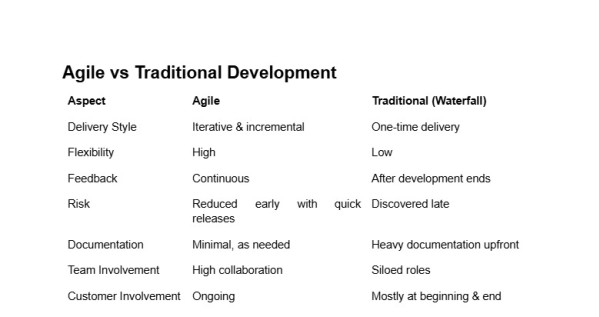
When building a software idea, the right development model can set the momentum for success and faster time-to-market ideas. Failing to choose the right model can be detrimental to the project. As per research, there is a significant increase in Agile adoption in software teams, rising from 37% in 2020 to 86% in 2021.
Agile is often combined with specific frameworks like Scrum and Kanban. Asoftware development company can go agile to deliver high-quality code on time. It is important to understand why agile has become a compelling choice for businesses worldwide.
Understanding Agile Software Development
Agile is a flexible, collaborative, and customer-focused approach to building software. It is a flexible, iterative approach to building software. It emphasizes collaboration, flexibility, and adaptability in the face of changing requirements. It focuses on delivering working software in short iterations, called sprints, rather than waiting for the entire project to be completed.
Why is the Agile Programming Method Used?
Agile helps teams deliver value faster and more frequently. Instead of waiting months for a final release, stakeholders can access early versions of the product, provide feedback, and help shape its evolution. The access to a quick feedback loop keeps development aligned with business goals.
● Adapts Quickly: Agile programming teams can respond to change without disrupting the project.
● Encourages Collaboration: Developers, stakeholders, and customers can work closely throughout the product-building process.
● Promotes Transparency: Frequent demos and updates keep everyone informed and aligned.
● Empowers Teams: Agile promotes cross-functional, self-organizing teams with shared ownership.
Agile Software Development Process
The Agile process is iterative and incremental, designed to produce working software in cycles known as iterations or sprints. Here’s how it works:
1. Understanding Requirements
The journey begins by closely connecting with the stakeholders to identify their business:
● Goals,
● Challenges
● Must-have features for the product
Instead of collecting everything upfront, the agile team focuses on high-priority needs. This helps to tailor the shape of the early versions of the product. These are documented as user stories and will evolve with feedback.
2. Strategic Planning
Once initial requirements are defined, the team creates a well-defined roadmap. As per the roadmap, the entire project is divided into short, time-boxed cycles (called sprints), with clear goals for each. In short, we prioritize tasks and estimate timelines. This helps to design a clear picture of what’s being delivered and when.
3. Iterative Development
The team starts coding based on sprint goals. Agile programming emphasizes building small, functional units of the product. Further, these units are tested and reviewed quickly. This paves the way for developers to quickly adapt to changes and ensure each release adds real value.
4. Continuous Testing
Under the agile approach, the testing cycle goes throughout development. Each feature is tested through automated and manual methods. This helps to ensure they work properly and fulfill expectations. Agile is a proven process for quickly catching bugs and eliminating them before they enter the production phase. This reduces long-term risk.
5. Deployment
Once a sprint delivers a working product increment, it’s deployed for users to access. Agile teams often use automated pipelines to push updates frequently. So, users benefit from new features and improvements without long waits.
6. Ongoing Maintenance
After release, the team stays involved. This includes monitoring performance, addressing issues, and refining the product based on user feedback. Agile encourages continuous enhancement so the software evolves with the business.
The 4 Core Values of Agile
As defined in the Agile Manifesto, Agile is built on four key values:
- Prioritize Individuals and Interactions Over Processes and Tools
- Working Software Over Comprehensive Documentation
- Customer Collaboration Over Contract Negotiation
- Responding to Change Over Following a Plan
12 Principles of Agile
Agile extends its values with 12 guiding principles, including:
● Deliver working software early and often.
● Welcome changing requirements—even late in development.
● Work closely with customers and stakeholders.
● Build around motivated individuals.
● Communicate face-to-face whenever possible.
● Measure progress by working software.
● Maintain a sustainable development pace.
● Focus on technical excellence and good design.
● Keep things simple.
● Let teams self-organize.
● Reflect regularly to improve effectiveness.
Design in Agile
Agile doesn’t separate design from development. Instead, design evolves alongside the code, often starting with just enough detail to get going. Each iteration improves both design and functionality. This avoids the risk of spending time designing features that may never be built or needed.
Real-World Example
Let’s say a tech company wants to launch a new browser in 10 months. Two teams are assigned:
● Team A follows a traditional Waterfall model, planning months in advance with strict phases.
● Team B chooses Agile, breaking the project into 2-week sprints and delivering basic functionality in the first few weeks.
When sudden changes are requested—like new features in 2 days—Team A is stuck in its planning phase. Team B, on the other hand, already has a working product and simply adds the new features to the next sprint.
Agile allows Team B to respond faster, deliver value earlier, and stay aligned with the company’s evolving goals.
Advantages of Agile
● Faster Delivery: Software is released in small, usable increments.
● Customer-Centric: Continuous feedback ensures the product fits real needs.
● Higher Quality: Frequent testing catches bugs early.
● Better Team Collaboration: Cross-functional teams work together closely.
● Increased Flexibility: Agile thrives in dynamic, fast-paced environments.
● Greater Visibility: Frequent updates and reviews build trust with stakeholders.
● Improved Morale: Empowered teams feel ownership and accountability.
Disadvantages of Agile
● Harder to Predict: Scope, budget, and timelines can shift frequently.
● Risk of Scope Creep: Constant changes may bloat the project if not managed.
● Requires Experienced Teams: Agile works best with seasoned developers.
● Documentation May Suffer: Less emphasis on detailed specs.
● Customer Involvement is Crucial: Low engagement from stakeholders can derail progress.
● May Struggle at Scale: Larger organizations may face coordination challenges.

Final Thoughts
Agile software development has reshaped how teams build software. It helps deliver high-quality software faster, with alignment to user needs. Whether you’re building a small app or a complex enterprise system, the Agile framework helps teams navigate uncertainty. So you can deliver value early and adapt on the move.

